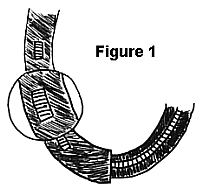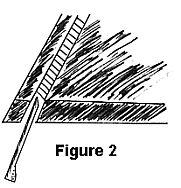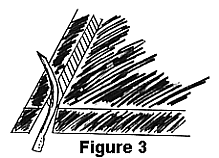 |
 |
 |
by Wendell Wells
published in the ANVIL Magazine, April 1994
Plagued by loose shoes?
Lost shoes?
Broken hooves?
Hooves cracking around the nail holes?
It is time to take the plunge - into the white line.
I can hear a collective shudder from those of us whose training led us to believe the white line (or lamina) was a forbidden zone of extreme sensitivity, sure to send the most mild-mannered horse into a wild kicking frenzy of pain if we so much as slid a nail close to this tortuous spot. Well, one afternoon as I was very carefully prying a chunk of gravel from the lamina (white line) of a mare I owned, I noticed that she seemed completely unaware that I was in the "forbidden zone." Not being reckless by nature, but having an overwhelming curiosity, I probed deeper. Still no reaction. Deeper. Nothing. Now this mare is an opportunist, and if I had so much as tickled her, she would have overreacted. Giddy with confidence and throwing caution to the wind, I took the plunge and nailed right into the center of the white line. I lived! Years have passed and I have driven hundreds of pounds of nails into the white line.
I have found this method to be many times superior to driving the nail into the fragile hoof wall. For starters, the shoe will stay on longer, thereby allowing shoeing intervals to be determined by hoof growth, not loose shoes. It is much easier to get higher nail placement when nailing into the lamina. If the shoe is pulled, the nails have a better chance of pulling through without taking a chunk of hoof with it.
Years ago many of us made our own shoes so that we could get the nail holes positioned over the white line and still get a full-fitting shoe. At that time, most manufactured shoes were made with the nail holes punched fine or close to the outer edge of the shoe, making it impossible to fit a shoe full and still nail into the white line. Today we have a wonderful selection of factory-made shoes with the nail holes punched fine or coarse for those of us who no longer have the time or inclination to make our own shoes.
After I position the nail hole over the white line (Figure 1), I place the nail head towards the frog. If you reverse this position, the nail will go into the sensitive structures of the hoof. Think of the tip of the nail as being similar to the bow of a boat. When the boat is moving slowly through the water, the bow, or, in this case, the nail tip stays flat; as the boat picks up speed, the bow lifts up. Starting with light taps of the nail hammer, I will drive the nail straight up the balsa-wood-textured white line or lamina (Figure 2). As the nail nears the point of desired exit, I strike the nail head with sharper blows. The beveled or prow-shaped nail tip will do its job and steer the nail tip to the outside of the hoof (Figure 3). As I strike the nail harder to bring the tip to the outside of the wall, i listen for a change in the sound of the hammer hitting the nail. This tone change lets me know that the nail tip has moved from the white line into the harder hoof wall. I am also feeling a change in resistance of the nail. If I am not hearing this tonal change or feeling the resistance at the time I would like to anticipate the nail tip exiting, I will then pull the nail out. Using the nail hammer and the edge of the shoe as my anvil, I will bend the tip into a more extreme prow shape. This will steer the nail tip out sooner.
 |
 |
 |
We all hate to return to put a loose or lost shoe back on. It cuts into our profit margin, and let's face it, lost shoes make us look bad. However, the true value of this information likes with the horses: I have seen hundreds of horses with chronically broken and chipped feet, horses you could barely find a place to nail a shoe on, make remarkable recoveries in only a few shoeing intervals, using this technique.
Wendell Wells has had horses since he was a child. He has been shoeing full time since 1985.
Return to the Farriery Articles listing page.